Research on the Tectonic Characteristics and Hydrocarbon Prospects in the Northern Area of the South Yellow Sea Based on Gravity and Magnetic Data
Abstract
:1. Introduction
2. Geological and Geophysical Setting
2.1. Geological Setting
2.2. Physical Properties
3. Data and Methodology
3.1. Data
3.2. Methodology
3.2.1. Regularization Filtering (RF)
3.2.2. Vertical Second Derivative (VSDR)
3.2.3. Normalized Vertical Derivative of Total Horizontal Derivative (NVDR-THDR)
3.2.4. Normalized Standard Deviation (NSTD)
3.2.5. Enhanced Gradient Amplitude (EHGA)
3.2.6. Improved Logistic Filter (IL)
3.2.7. Constrained Modelling of 2.5D Gravity Profile
3.2.8. Regression Analysis (RA)
4. Results and Analysis
4.1. Characteristics and Geological Significance of Gravity and Magnetic Anomalies
4.1.1. Characteristics and Geological Significance of Bouguer Gravity Anomaly
4.1.2. Characteristics and Geological Significance of the Magnetic Anomaly
4.2. Fault Structure
4.3. 2.5D Gravity Modelling
4.4. Basement Interface Inversion and Hydrocarbon Prospect Area
4.4.1. Interface Inversion
4.4.2. Basement Features
5. Discussion
5.1. Relationship between Tectonic Movement and Hydrocarbons
5.2. Hydrocarbon Prospect Area
6. Conclusions
Author Contributions
Funding
Data Availability Statement
Acknowledgments
Conflicts of Interest
References
- Zhang, J.Q. Exploration prospects of Mesozoic and Paleozoic oil and gas in the South Yellow Sea. Mar. Geol. Lett. 2002, 18, 25–27. (In Chinese) [Google Scholar]
- Feng, Z.Q.; Yao, Y.J.; Zeng, X.H.; Wang, Q.; Wang, L.L.; Chen, Q.; Yi, H.; Jin, H.F. New understanding of Mesozoic-Paleozoic tectonics and hydrocarbon potential in Yellow Sea. China Offshore Oil Gas (Geol.) 2002, 16, 367–373. (In Chinese) [Google Scholar]
- Wu, S.G.; Ni, X.L.; Cai, F. Petroleum geological framework and hydrocarbon potential in the Yellow Sea. Chin. J. Oceanol. Limnol. 2008, 26, 23–34. [Google Scholar] [CrossRef]
- Yao, Y.J.; Chen, C.F.; Feng, Z.Q.; Zhang, S.Y.; Hao, T.Y.; Wan, R.S. Tectonic evolution and hydrocarbon potential in northern area of the South Yellow Sea. J. Earth Sci. 2010, 21, 71–82. [Google Scholar] [CrossRef]
- Liang, J.; Zhang, P.H.; Chen, J.W.; Gong, J.M.; Yuan, Y. Hydrocarbon preservation conditions in Mesozoic-Paleozoic marine strata in the South Yellow Sea Basin. Nat. Gas Ind. B 2017, 4, 432–441. [Google Scholar] [CrossRef]
- Chen, J.W.; Xua, M.; Lei, B.H.; Liang, J.; Zhang, Y.G.; Wu, S.Y.; Shi, J.; Yuan, Y.; Wang, J.Q.; Zhang, Y.X.; et al. Prospective prediction and exploration situation of marine Mesozoic-Paleozoic oil and gas in the South Yellow Sea. China Geol. (Engl. Ed.) 2019, 1, 67–84. [Google Scholar] [CrossRef]
- Lei, B.H.; Chen, J.W.; Liang, J.; Zhang, Y.G. Structural Characteristics and Favorable Zone for Marine Hydrocarbon Exploration of the Laoshan Uplift in the South Yellow Sea Basin. Acta Geol. Sin. (Engl. Ed.) 2019, 93, 102–103. [Google Scholar]
- Yuan, Y.; Chen, J.W.; Liang, J.; Xu, M.; Lei, B.H.; Zhang, Y.X.; Cheng, Q.S.; Wang, J.Q. Hydrocarbon geological conditions and exploration potential of Mesozoic–Paleozoic marine strata in the South Yellow Sea Basin. J. Ocean Univ. China (Ocean. Coast. Sea Res.) 2019, 18, 1329–1343. [Google Scholar] [CrossRef]
- Pang, Y.M.; Guo, X.W.; Han, Z.Z.; Zhang, X.H.; Zhu, X.Q.; Hou, F.H.; Han, C.; Song, Z.G.; Xiao, G.L. Mesozoic–Cenozoic denudation and thermal history in the Central Uplift of the South Yellow Sea basin and the implications for hydrocarbon systems: Constraints from the CSDP-2 borehole. Mar. Pet. Geol. 2019, 99, 355–369. [Google Scholar] [CrossRef]
- Cai, L.X.; Xiao, G.L.; Guo, X.W.; Wang, J.; Wu, Z.Q.; Li, B.G. Assessment of Mesozoic and Upper Paleozoic source rocks in the South Yellow Sea Basin based on the continuous borehole CSDP-2. Mar. Pet. Geol. 2019, 101, 30–42. [Google Scholar] [CrossRef]
- Cai, L.X.; Xiao, G.L.; Zeng, Z.G.; Zhang, X.H.; Guo, X.W.; Wang, S.P. New insights into marine hydrocarbon geological conditions in the South Yellow Sea Basin: Evidence from borehole CSDP-2. J. Oceanol. Limnol. 2020, 38, 1169–1187. [Google Scholar] [CrossRef]
- Wang, J.Q.; Sun, J.; Xiao, G.L.; Wu, Z.Q.; Li, S.L. Tectonic characteristics of the South Yellow Sea basin and implications for petroleum geology. Mar. Geol. Front. 2014, 30, 34–39. (In Chinese) [Google Scholar]
- Zhang, X.H.; Guo, X.W.; Wu, Z.Q.; Xiao, G.L.; Zhang, X.H.; Zhu, X.Q. Preliminary results and geological significance of Well CSDP-2 in the Central Uplift of South Yellow Sea Basin. Chin. J. Geophys. 2019, 62, 197–218. (In Chinese) [Google Scholar]
- Zhang, X.H.; Yang, J.Y.; Li, G.; Yang, Y.Q. Basement structure and distribution of Mesozoic-Paleozoic marine strata in the South Yellow Sea basin. Chin. J. Geophys. 2014, 57, 4041–4051. (In Chinese) [Google Scholar]
- Lei, B.H.; Xu, M.; Chen, J.W.; Liang, J.; Zhang, Y.G. Structural characteristics and evolution of the South Yellow Sea Basin since Indosinian. China Geol. 2018, 4, 466–476. [Google Scholar] [CrossRef]
- Feng, Z.Q.; Chen, C.F.; Yao, Y.J.; Zhang, S.Y.; Hao, T.Y.; Wan, R.S. Tectonic evolution and exploration target of the northern foreland basin of the South Yellow Sea. Earth Sci. Front. 2008, 15, 219–231. (In Chinese) [Google Scholar]
- Zhang, X.H.; Xiao, G.L.; Wu, Z.Q.; Li, S.L. Recognition and Discussion of Several Geological Problems in Oil&Gas Exploration of the South Yellow Sea—New Progress and Challenges in the Mesozoic-Paleozoic Marine Oil&Gas Exploration of the South Yellow Sea; Science Press: Beijing, China, 2017. (In Chinese) [Google Scholar]
- Cai, Q.Z. Oil & Gas Geology in China Seas; China Ocean Press: Beijing, China, 2005. (In Chinese) [Google Scholar]
- Ma, L.F. Geological Atlas of China (Shandong Geological Map & Jiangsu Geological Map); Geological Publishing House: Beijing, China, 2002. (In Chinese) [Google Scholar]
- Becker, J.J.; Sandwell, T.D.; Smith, W.H.F.; Braud, J.; Binder, B.; Depner, J.; Fabre, D.; Factor, J.; Ingalls, S.; Kim, S.-H.; et al. Global bathymetry and elevation data at 30 arc seconds resolution: SRTM30_PLUS. Mar. Geod. 2009, 32, 355–371. [Google Scholar] [CrossRef]
- Yao, Y.J.; Feng, Z.Q.; Hao, T.Y.; Xu, X.; Li, X.J.; Wan, R.S. A new understanding of structural layers in the South Yellow Sea Basin and their hydrocarbon-bearing characteristics. Earth Sci. Front. 2008, 15, 232–240. (In Chinese) [Google Scholar]
- Zhang, H.Q.; Chen, J.W.; Li, G.; Li, G.; Wu, Z.Q.; Zhang, Y.G. Discovery from seismic survey in Laoshan Uplift of the South Yellow Sea and the significance. Mar. Geol. Quat. Geol. 2009, 29, 107–113. (In Chinese) [Google Scholar]
- Wang, L.Y. Research on Pre-Tertiary Seismic Stratigraphy and Structural Characteristics of the South Yellow Sea. Master’s Thesis, Ocean University of China, Qingdao, China, 2011. (In Chinese). [Google Scholar]
- Li, N.; Li, W.R.; Long, H.Y. Tectonic evolution of the north depression of the South Yellow Sea Basin since Late Cretaceous. J. Ocean Univ. China (Ocean. Coast. Sea Res.) 2016, 15, 967–976. [Google Scholar] [CrossRef]
- Xu, H.; Zhang, H.Y.; Zhang, B.L.; Yan, G.J.; Shi, J.; Yang, Y.Q.; Sun, H.Q.; Li, J.W.; Dong, G.; Lu, S.C. Characteristics of the 26 wells from the South Yellow Sea Basin. Mar. Geol. Front. 2015, 31, 1–6. (In Chinese) [Google Scholar]
- Xu, X.; Sun, L.P.; Xiao, M.C.; Li, X.; Zhu, X.Y.; Gao, S.L. Structural characteristics and activity rules of faults in the Cenozoic faulted-basins in the Lower Yangtze Region. Geol. J. China Univ. 2018, 24, 723–733. (In Chinese) [Google Scholar]
- Yuan, Y.; Chen, J.W.; Zhang, Y.X.; Liang, J.; Zhang, Y.G.; Zhang, P.H. Tectonic evolution and geological characteristics of hydrocarbon reservoirs in marine Mesozoic-Paleozoic strata in the South Yellow Sea Basin. J. Ocean Univ. China (Ocean. Coast. Sea Res.) 2018, 17, 1075–1090. [Google Scholar] [CrossRef]
- Xu, M.; Chen, J.W.; Liang, J.; Zhang, Y.G.; Lei, B.H.; Shi, J.; Wang, J.Q. Basement structures underneath the northern South Yellow Sea basin (East China): Implications for the collision between the North China and South China blocks. J. Asian Earth Sci. 2019, 186, 104040. [Google Scholar] [CrossRef]
- Qi, J.H. Research on the Crustal Velocity Structure in the Southern Yellow Sea. Ph.D. Thesis, Ocean University of China, Qingdao, China, 2015. (In Chinese). [Google Scholar]
- Hou, F.H.; Guo, X.W.; Wu, Z.Q.; Zhu, X.Q.; Zhang, X.H.; Qi, J.H.; Wang, B.J.; Wen, Z.H.; Cai, L.X.; Pang, Y.M. Research progress and discussion on formation and tectonics of South Yellow Sea. J. Jinlin Univ. (Earth Sci. Ed.) 2019, 49, 96–105. (In Chinese) [Google Scholar]
- Zhao, W.N.; Wang, H.G.; Shi, H.C.; Xie, H.; Wu, Z.Q.; Chen, S.S.; Zhang, X.H.; Hao, T.Y.; Zheng, P.H. Crustal structure from onshore-offshore wide-angle seismic data: Application to Northern Sulu Orogen and its adjacent area. Tectonophysics 2019, 770, 1–12. [Google Scholar] [CrossRef]
- Liu, L.H.; Hao, T.Y.; Lü, C.C.; Wu, Z.Q.; Zheng, Y.P.; Wang, F.Y.; Xu, Y.; Kim, K.; Kim, H. Crustal deformation and detachment in the Sulu Orogenic Belt: New constraints from Onshore-Offshore Wide-Angle seismic data. Geophys. Res. Lett. 2021, 48, 1–10. [Google Scholar] [CrossRef]
- Berezkin, V.M. Method of analytical continuation of total vertical gradient of gravity field for the study of density masses distribution in the earth crust. Geol. I Razved. (Geol. Explor.) 1968, 12, 104–110. (In Russian) [Google Scholar]
- Berezkin, W.M. Application of the full vertical gravity gradient to determination to sources causing gravity anomalies. Expl. Geopys. 1967, 18, 69–76. (In Russian) [Google Scholar]
- Berezkin, W.M. Application of Gravity Exploration to Reconnaissance of Oil and Gas Reservoir; Nedra Publishing House: Moscow, Russia, 1973. (In Russian) [Google Scholar]
- Zeng, H.L.; Meng, X.H.; Yao, C.L.; Li, X.M.; Lou, H.; Guan, Z.N.; Li, Z.P. Detection of reservoirs from normalized full gradient of gravity anomalies and its application to Shengli oil field, east China. Geophysics 2002, 67, 1138–1147. [Google Scholar] [CrossRef]
- Aydin, A. Interpretation of gravity anomalies with the normalized full gradient (NFG) method and an example. Pure Appl. Geophys. 2007, 164, 2329–2344. [Google Scholar] [CrossRef]
- Aghajani, H.; Moradzadeh, A.; Zeng, H.L. Detection of high-potential oil and gas fields using normalized full gradient of gravity anomalies: A case study in the Tabas Basin, Eastern Iran. Pure Appl. Geophys. 2011, 168, 1851–1863. [Google Scholar] [CrossRef]
- Yuan, B.Q.; Song, L.J.; Han, L.; An, S.L.; Zhang, C.G. Gravity and magnetic field characteristics and hydrocarbon prospects of the Tobago Basin. Geophys. Prospect. 2018, 66, 1586–1601. [Google Scholar] [CrossRef]
- Saada, S.A.; Mickus, K.; Eldosouky, A.M.; Ibrahim, A. Insights on the tectonic styles of the Red Sea rift using gravity and magnetic data. Mar. Pet. Geol. 2021, 133, 105253. [Google Scholar] [CrossRef]
- Eldosoukya, A.M.; Pham, L.T.; Duong, V.-H.; Eitel, F.; Ghomsid, K.; Henaish, A. Structural interpretation of potential field data using the enhancement techniques: A case study. Geocarto Int. 2022, 37, 16900–16925. [Google Scholar] [CrossRef]
- Pham, L.T.; Nguyen, D.A.; Eldosouky, A.M.; Abdelrahman, K.; Vu, T.V.; Al-Otaibi, N.; Ibrahim, E.; Kharbish, S. Subsurface structural mapping from high-resolution gravity data using advanced processing methods. J. King Saud Univ.-Sci. 2021, 33, 101488. [Google Scholar] [CrossRef]
- Saada, S.A.; Eldosouky, A.M.; Kamel, M.; Khadragy, A.E.; Abdelrahman, K.; Fnais, M.S.; Mickus, K. Understanding the structural framework controlling the sedimentary basins from the integration of gravity and magnetic data: A case study from the east of the Qattara Depression area, Egypt. J. King Saud Univ.-Sci. 2022, 34, 101808. [Google Scholar] [CrossRef]
- Eldosouky, A.M.; Pham, L.T.; Henaish, A. High precision structural mapping using edge filters of potential field and remote sensing data: A case study from Wadi Umm Ghalqa area, South Eastern Desert, Egypt. Egypt. J. Remote Sens. Space Sci. 2022, 25, 501–513. [Google Scholar] [CrossRef]
- El-Sehamy, M.; Gawad, A.M.A.; Aggour, T.A.; Orabi, O.H.; Abdella, H.F.; Eldosouky, A.M. Sedimentary cover determination and structural architecture from gravity data: East of Suez Area, Sinai, Egypt. Arab. J. Geosci. 2022, 15, 109. [Google Scholar] [CrossRef]
- Pham, L.T.; Ghoms, F.E.K.; Vu, T.V.; Oksum, E.; Steffen, R.; Tenzer, R. Mapping the structural configuration of the western Gulf of Guinea using advanced gravity interpretation methods. Phys. Chem. Earth 2023, 129, 103341. [Google Scholar] [CrossRef]
- Liang, R.C.; Pei, Y.L.; Zheng, Y.P.; Wei, J.W.; Liu, Y.G. Gravity and magnetic field and tectonic structure character in the southern Yellow Sea. Chin. Sci. Bull. 2003, 48, 64–73. [Google Scholar] [CrossRef]
- Wang, W.Y.; Liu, J.L.; Qiu, Z.Y.; Huang, Y.J.; Cai, D.S. A research on Mesozoic thickness using satellite gravity anomaly in the southern Yellow Sea. China Offshore Oil Gas 2004, 16, 151–156,169. (In Chinese) [Google Scholar]
- Zhang, M.H.; Xu, D.S.; Chen, J.W. Geological structure of the yellow sea area from regional gravity and magnetic interpretation. Appl. Geophys. 2007, 4, 75–83. [Google Scholar] [CrossRef]
- Yao, Y.J. Tectonic of the South Yellow Sea: Application of Joint Gravity-Magnetic-Seismic Inversion. Ph.D. Thesis, Guangzhou Institute of Geochemistry, Chinese Academy of Sciences, Guangzhou, China, 2008. (In Chinese). [Google Scholar]
- Hao, T.Y.; Huang, S.; Xu, Y.; Li, Z.W.; Zhang, L.L.; Wang, J.L.; Suh, M.; Kim, K. Geophysical understandings on deep structure in Yellow Sea. Chin. J. Geophys. 2010, 53, 1315–1326. (In Chinese) [Google Scholar]
- Yang, J.Y. Research on the Tectonic Relation between the South Yellow Sea Basin and Its Adjacent Area and Distribution Characteristic and Tectonic Evolution of the Mesozoic-Paleozoic Marine Strata. Ph.D. Thesis, Zhejiang University, Hangzhou, China, 2009. (In Chinese). [Google Scholar]
- Choi, S.C.; Ryu, I.-C.; Gotze, H.-J. Depth distribution of the sedimentary basin and Moho undulation in the Yellow Sea, NE Asia interpreted by using satellite-derived gravity field. Geophys. J. Int. 2015, 202, 41–53. [Google Scholar] [CrossRef] [Green Version]
- Zhang, X.J.; Zhang, W.; Fan, Z.L.; Zhu, W.P.; Tong, J.; Yao, G.T. Characteristics of airborne gravity field and the main geological discovery in the northern South Yellow Sea. Geol. Surv. China 2017, 4, 50–56. (In Chinese) [Google Scholar] [CrossRef] [Green Version]
- Tong, J.; Zhang, X.J.; Zhang, W.; Xiong, S.Q. Marine strata morphology of the South Yellow Sea based on high-resolution aeromagnetic and airborne gravity data. Mar. Pet. Geol. 2018, 96, 429–440. [Google Scholar] [CrossRef]
- Zhang, R.Y.; Yang, F.L.; Zhao, C.J.; Zhang, J.W.; Qiu, E.K. Coupling relationship between sedimentary basin and Moho morphology in the South Yellow Sea, East China. Geol. J. 2020, 55, 6544–6561. [Google Scholar] [CrossRef]
- Xu, W.Q.; Yuan, B.Q.; Liu, B.L.; Yao, C.L. Multiple gravity and magnetic potential field edge detection methods and their application to the boundary of fault structures in northern South Yellow Sea. Geophys. Geochem. Explor. 2020, 44, 962–974. (In Chinese) [Google Scholar]
- Jin, X.L.; Yu, P.Z. Geological Structure of the Yellow Sea and East China Sea; Science Press: Beijing, China, 1982. (In Chinese) [Google Scholar]
- Qin, Y.S.; Zhao, Y.Y. The Yellow Sea Geology; China Ocean Press: Beijing, China, 1989. (In Chinese) [Google Scholar]
- Chen, H.S.; Zhang, Y.H. The Lithospheric Textural and Structural Features as Well as Oil and Gas Evaluation in the Lower Yangtze Area and Its Adjacent Region; Geological Publishing House: Beijing, China, 1999. (In Chinese) [Google Scholar]
- Sun, X.D.; Guo, X.W.; Zhang, X.H.; Li, Z.Y.; Liu, H.S.; Zhang, S.S. Radiogentic heat production of formation and thermal structure of lithosphere in the South Yellow Sea Basin. Earth Sci. 2023, 48, 1040–1057. (In Chinese) [Google Scholar]
- Xiao, G.L.; Zhang, Y.G.; Wu, Z.Q.; Lei, B.H.; Sun, J.; Wang, J.Q. Comparative assessment of hydrocarbon resource potential in the South Yellow Sea Basin. Mar. Geol. Front. 2014, 30, 25–33. (In Chinese) [Google Scholar]
- Xu, Z.Q.; Liang, J.; Chen, J.W.; Zhang, P.H.; Zhang, Y.G.; Wang, J.Q.; Lei, B.H.; Yang, C.S. Evaluation of hydrocarbon preservation on the Laoshan uplift. Mar. Geol. Quat. Geol. 2018, 38, 125–133. (In Chinese) [Google Scholar]
- Zhang, M.Q.; Gao, S.L.; Tan, S.Z. Geological characteristics of the Meso-Paleozoic in South Yellow Sea Basin and future exploration. Mar. Geol. Quat. Geol. 2018, 38, 24–34. (In Chinese) [Google Scholar]
- Zhang, X.H.; Zhang, X.H.; Wu, Z.Q.; Guo, X.W.; Xiao, G.L. New understanding of Mesozoic-Paleozoic strata in the central uplift of the South Yellow Sea basin from the drilling of well CSDP-02 OF THE “Continental Shelf Drilling Program”. Chin. J. Geophys. 2018, 61, 2369–2379. (In Chinese) [Google Scholar]
- Tan, S.Z.; Chen, C.F.; Xu, Z.Z.; Hou, K.W.; Wang, J. Geochemical characteristics and hydrocarbon generation potentials of Paleozoic source rocks in the Southern Yellow Sea basin. Mar. Geol. Quat. Geol. 2018, 38, 116–124. (In Chinese) [Google Scholar]
- Fu, Y.X.; Tan, S.Z.; Hou, K.W. Formation conditions and resource potentiality of Taizhou formation in north sag of South Yellow Sea Basin. J. Jilin Univ. (Earth Sci. Ed.) 2019, 49, 230–238. (In Chinese) [Google Scholar]
- Chen, Q.H.; Song, R.W.; Dai, J.S.; Lu, K.Z.; Xiong, J.H. Jiaolai basin gravity and magnetic data interpretation and structure analysis. Prog. Geophys. 1994, 9, 70–79. (In Chinese) [Google Scholar]
- Huang, T.L. Characteristic of regional geophysical field in Jiaolai Basin and its tectonic unit division. Shandong Geol. 2000, 16, 41–47. (In Chinese) [Google Scholar]
- An, Y.L.; Guan, Z.N. The regularized stable factors of removing high frequency disturbances. Comput. Tech. Geophys. Geochem. Explor. 1985, 7, 13–23. (In Chinese) [Google Scholar]
- Morozov, V.A. Methods for Solving Incorrectly Posed Problems; Springer: New York, NY, USA, 1984; pp. 1–31. [Google Scholar]
- Boschetti, F. Improved edge detection and noise removal in gravity maps via the use of gravity gradients. J. Appl. Geophys. 2005, 57, 213–225. [Google Scholar] [CrossRef]
- Zeng, H.L. Gravity Field and Gravity Exploration; In Chinese with English Contents; Geological Publishing House: Beijing, China, 2005. (In Chinese) [Google Scholar]
- Rosenbach, O. A Contribution to the computation of the “Second Derivative” from Gravity Data. Geophysics 1953, 18, 3113–3123. [Google Scholar] [CrossRef]
- Wang, W.Y. The Research on the Edge Recognition Methods and Techniques for Potential Field. Ph.D. Thesis, Chang’an University, Xi’an, China, 2009. (In Chinese). [Google Scholar]
- Cooper GR, J.; Cowan, D.R. Edge enhancement of potential-field data using normalized statistics. Geophysics 2008, 73, 1–4. [Google Scholar] [CrossRef]
- Pham, L.T.; Eldosouky, A.M.; Oksum, E.; Saada, S.A. A new high resolution filter for source edge detection of potential field data. Geocarto Int. 2020, 37, 3051–3068. [Google Scholar] [CrossRef]
- Ekwok, S.E.; Eldosouky, A.M.; Achadu, O.I.M.; Akpan, A.E.; Pham, L.T.; Abdelrahman, K.; Gómez-Ortiz, D.; Ben, U.C.; Fnais, M.S. Application of the enhanced horizontal gradient amplitude (EHGA) filter in mapping of geological structures involving magnetic data in southeast Nigeria. J. King Saud Univ. Sci. 2022, 34, 102288. [Google Scholar] [CrossRef]
- Pham, L.T.; Vu, T.V.; Thi, S.L.; Trinh, P.T. Enhancement of potential field source boundaries using an Improved Logistic Filter. Pure Appl. Geophys. 2020, 177, 5237–5249. [Google Scholar] [CrossRef]
- Pham, L.T.; Oksum, E.; Do, T.D.; Le-Huy, M. New method for edges detection of magnetic sources using logistic function. Geofiz. Zhurnal. 2018, 40, 127–135. [Google Scholar] [CrossRef] [Green Version]
- Parker, R.L. The rapid calculation of potential anomalies. Geophys. J. Int. 1973, 31, 447–455. [Google Scholar] [CrossRef] [Green Version]
- Oldenburg, D.W. The inversion and interpretation of gravity anomalies. Geophysics 1974, 39, 526–536. [Google Scholar] [CrossRef]
- Florio, G. Mapping the depth to basement by Iterative Rescaling of Gravity or Magnetic Data. J. Geophys. Res. Solid Earth 2018, 123, 9101–9120. [Google Scholar] [CrossRef]
- Liu, Y.M.; Wu, Z.P. Diachronous characteristics and genetic mechanism of the Paleogene tectonic transition in Bohai Bay basin: A case study of the southwest Bohai Sea and Jiyang Depression. J. Cent. South Univ. (Sci. Technol.) 2022, 53, 1095–1110. [Google Scholar]
- Qi, J.H. Mesozoic-Paleozoic Tectonic Evolution in the South Yellow Sea Basin and the Comparative Analysis with Sichuan Basin. Master’s Thesis, China University of Geosciences, Beijing, China, 2012. (In Chinese). [Google Scholar]
- Xiao, Q.B.; Zhao, G.Z.; Wang, J.J.; Zhan, Y.; Chen, X.B.; Tang, J.; Cai, J.T.; Wan, Z.S.; Wang, L.F.; Ma, W.; et al. Deep electrical structure of the Sulu Orogen and neighboring areas. Sci. China Ser. D Earth Sci. 2009, 52, 420–430. [Google Scholar] [CrossRef]
- Pang, Y.M.; Zhang, X.H.; Xiao, G.L.; Guo, X.W.; Wen, Z.H.; Wu, Z.Q.; Zhu, X.Q. Characteristics of Meso-Cenozoic igneous complexes in the South Yellow Sea Basin, Lower Yangtze Craton of Eastern China and the tectonic setting. Acta Geol. Sin. (Engl. Ed.) 2017, 91, 971–987. [Google Scholar] [CrossRef]
- Pang, Y.M.; Zhang, X.H.; Xiao, G.L.; Shang, L.N.; Guo, X.W.; Wen, Z.H. The Mesozoic-Cenozoic igneous intrusions and related sediment-dominated hydrothermal activities in the South Yellow Sea Basin, the Western Pacific continental margin. J. Mar. Syst. 2018, 180, 152–161. [Google Scholar]
- Chen, J.W.; Xu, M.; Lei, B.H.; Shi, J.; Liu, J. Collision of North China and Yangtze Plates: Evidence from the South Yellow Sea. Mar. Geol. Quat. Geol. 2020, 40, 1–12. (In Chinese) [Google Scholar]
- Xing, T.; Zhang, X.H.; Zhang, X.Y. Magnetic basement and structure of the Southern Yellow Sea. Oceanol. Limnol. Sin. 2014, 45, 946–953. (In Chinese) [Google Scholar]
- Li, W.Y.; Liu, Y.X.; Xu, J.C. Onshore–offshore structure and hydrocarbon potential of the South Yellow Sea. J. Asian Earth Sci. 2014, 90, 127–136. [Google Scholar] [CrossRef]

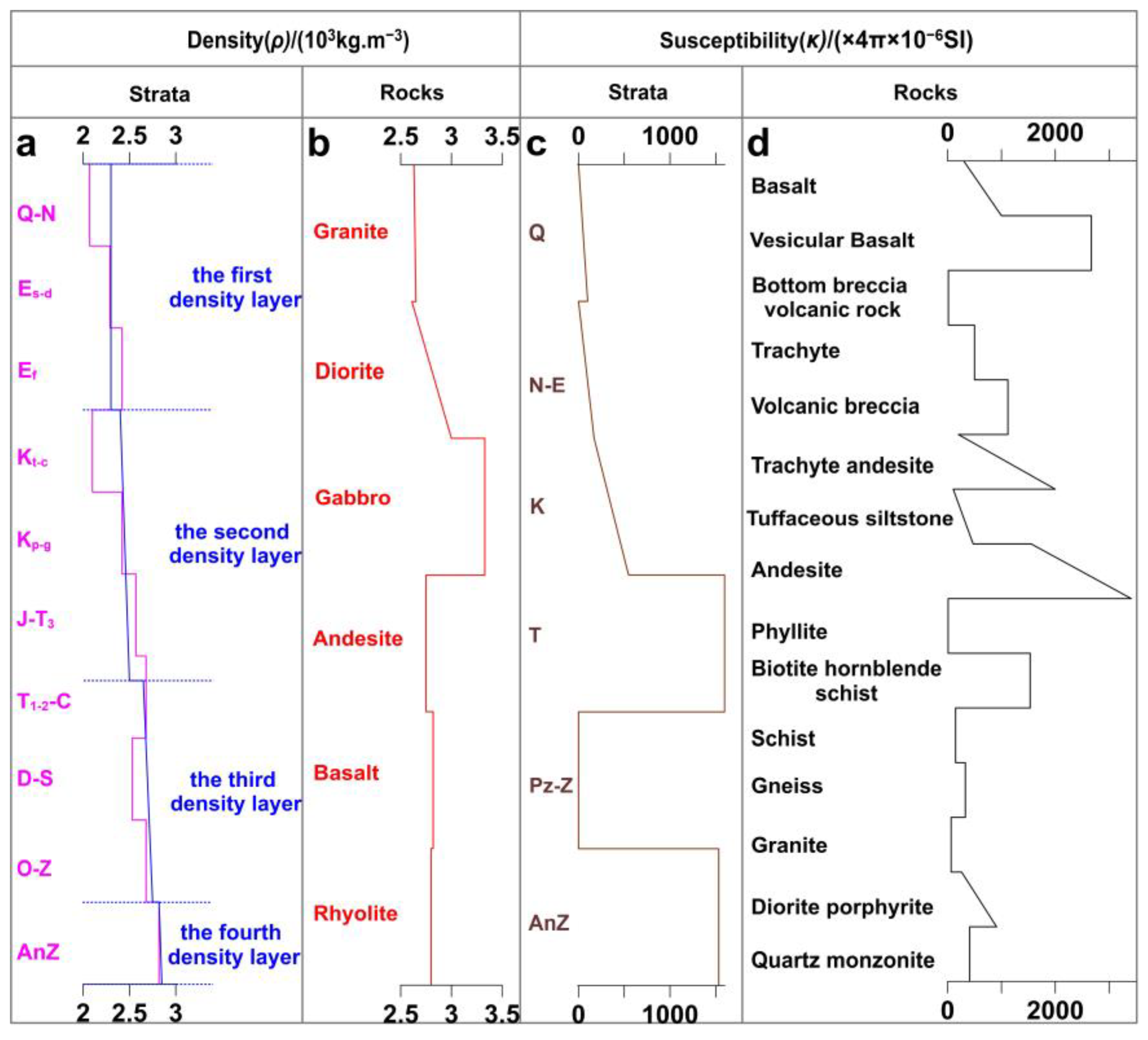


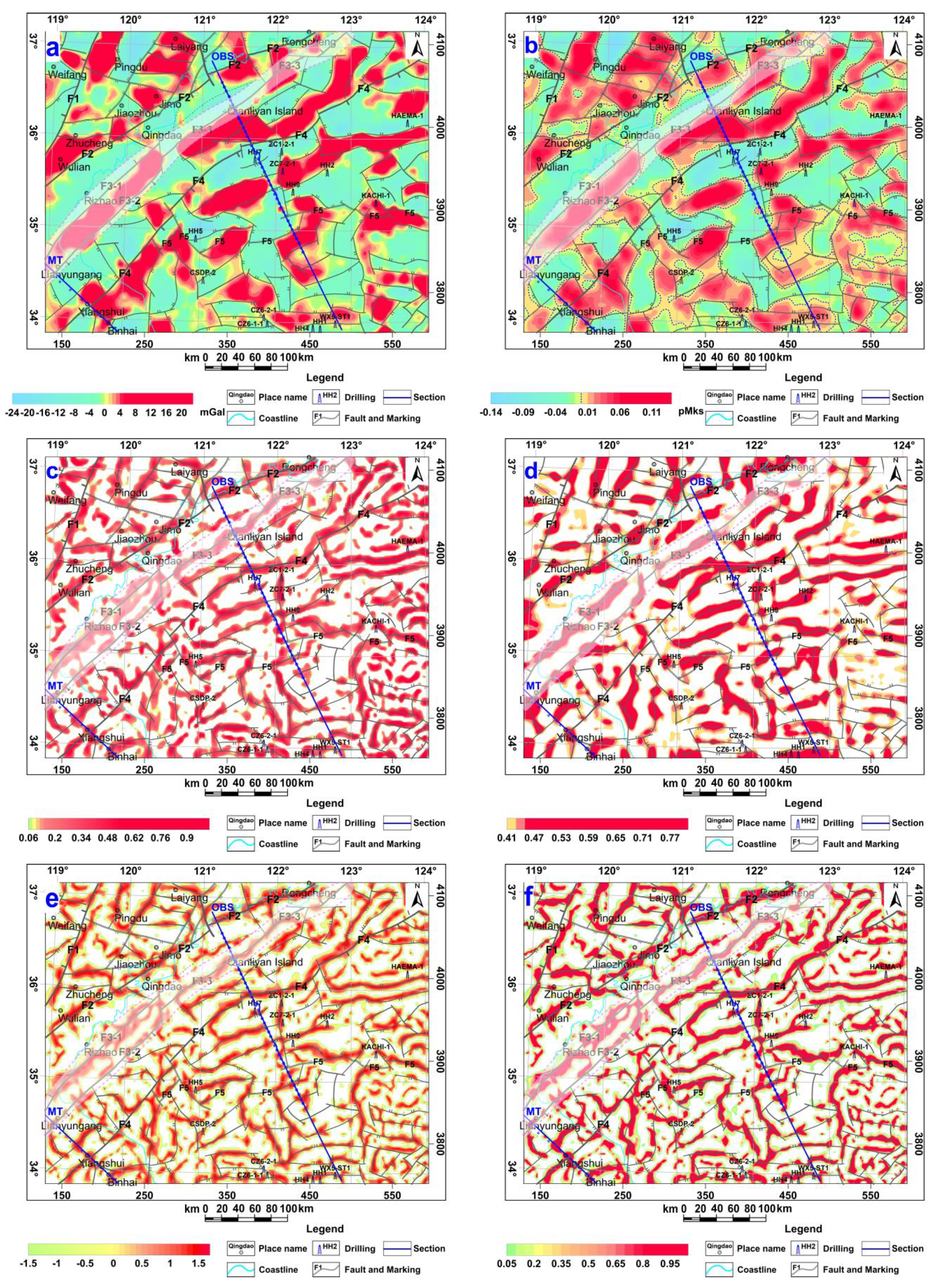

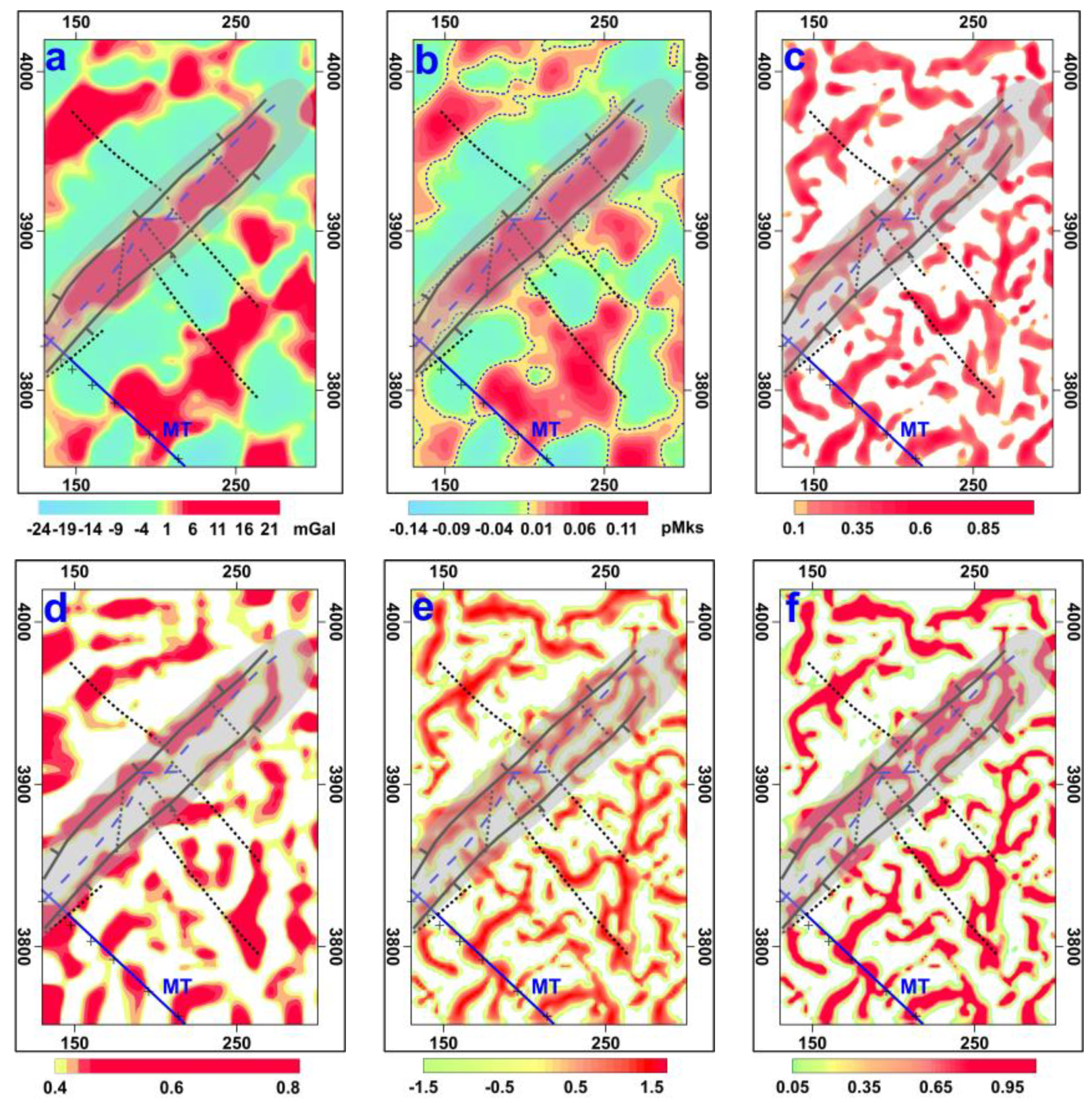


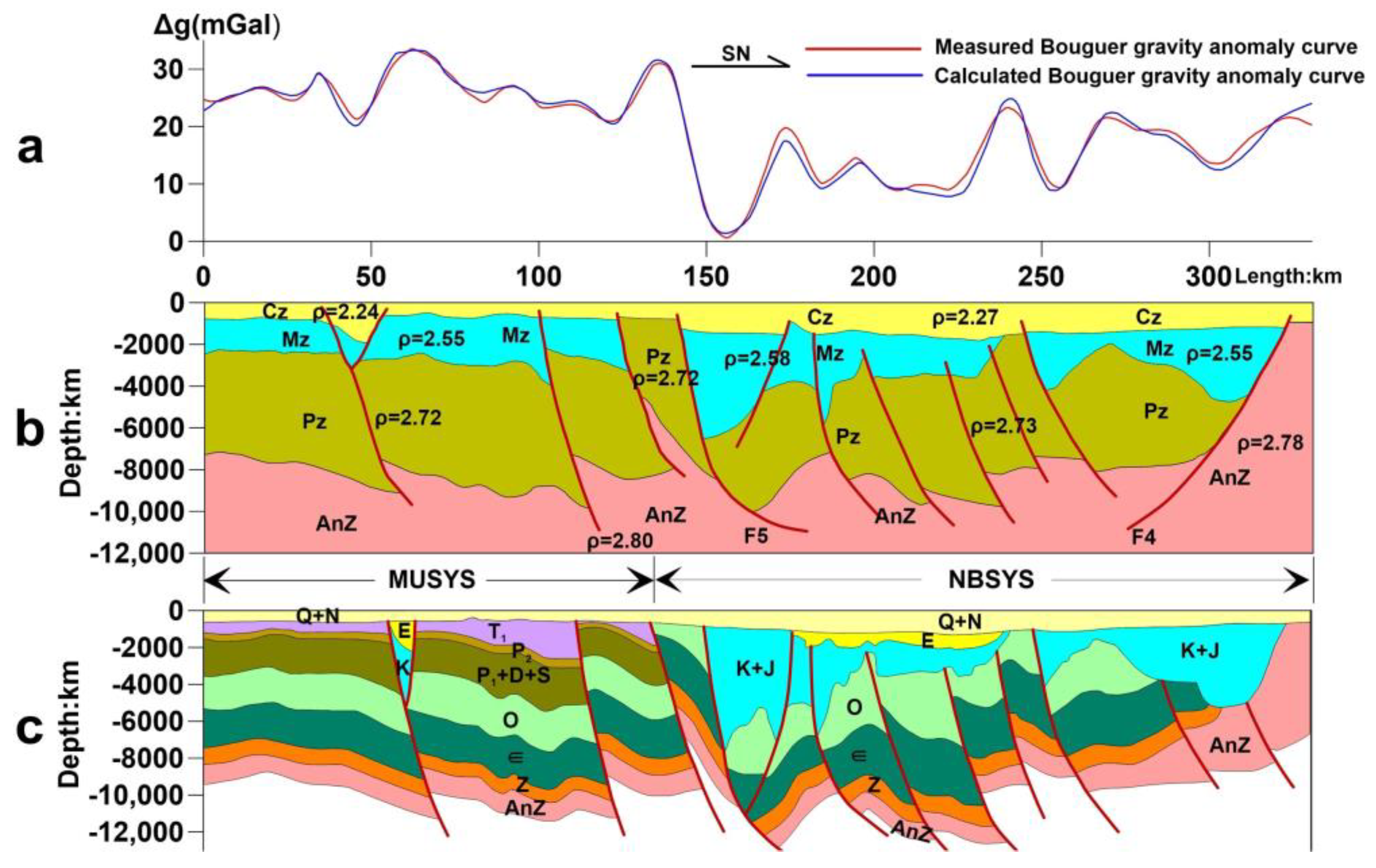
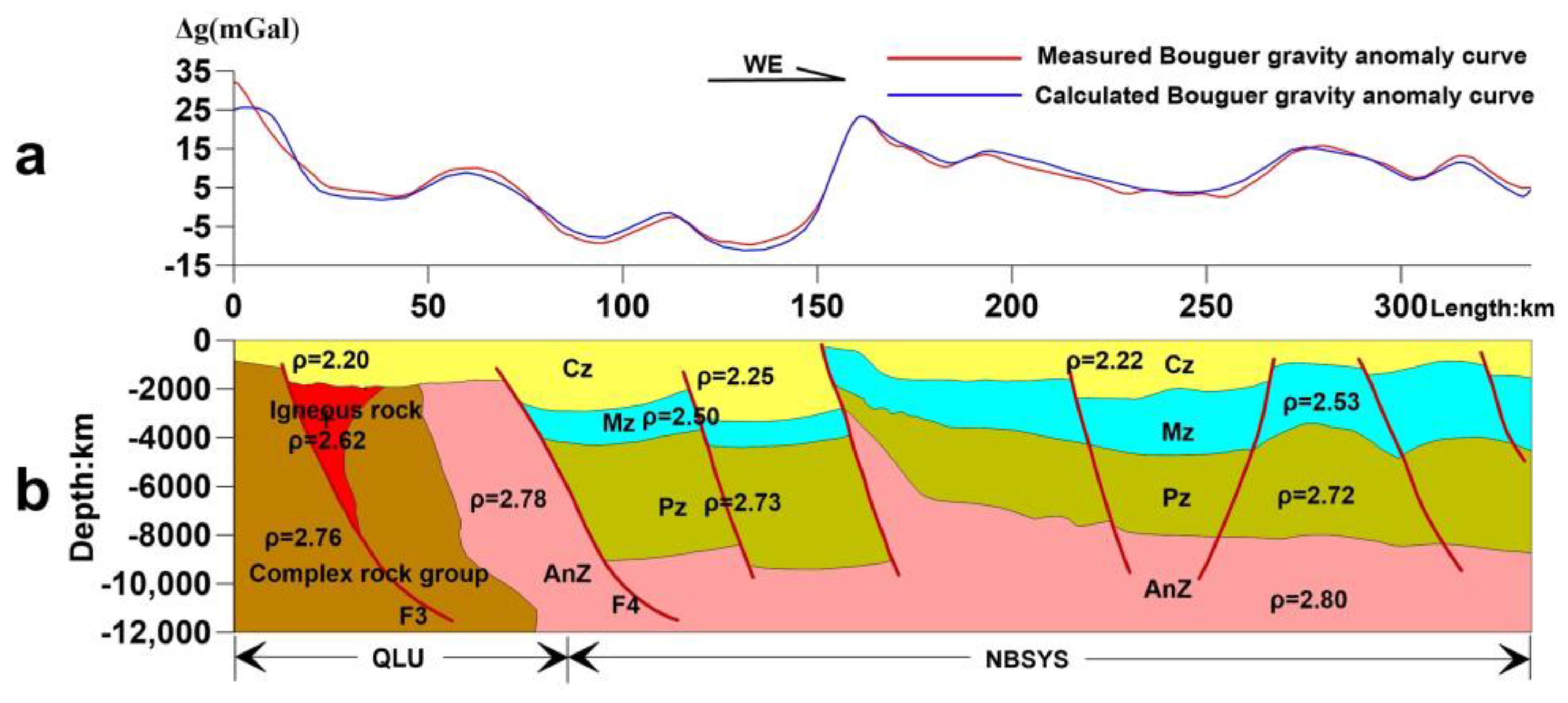
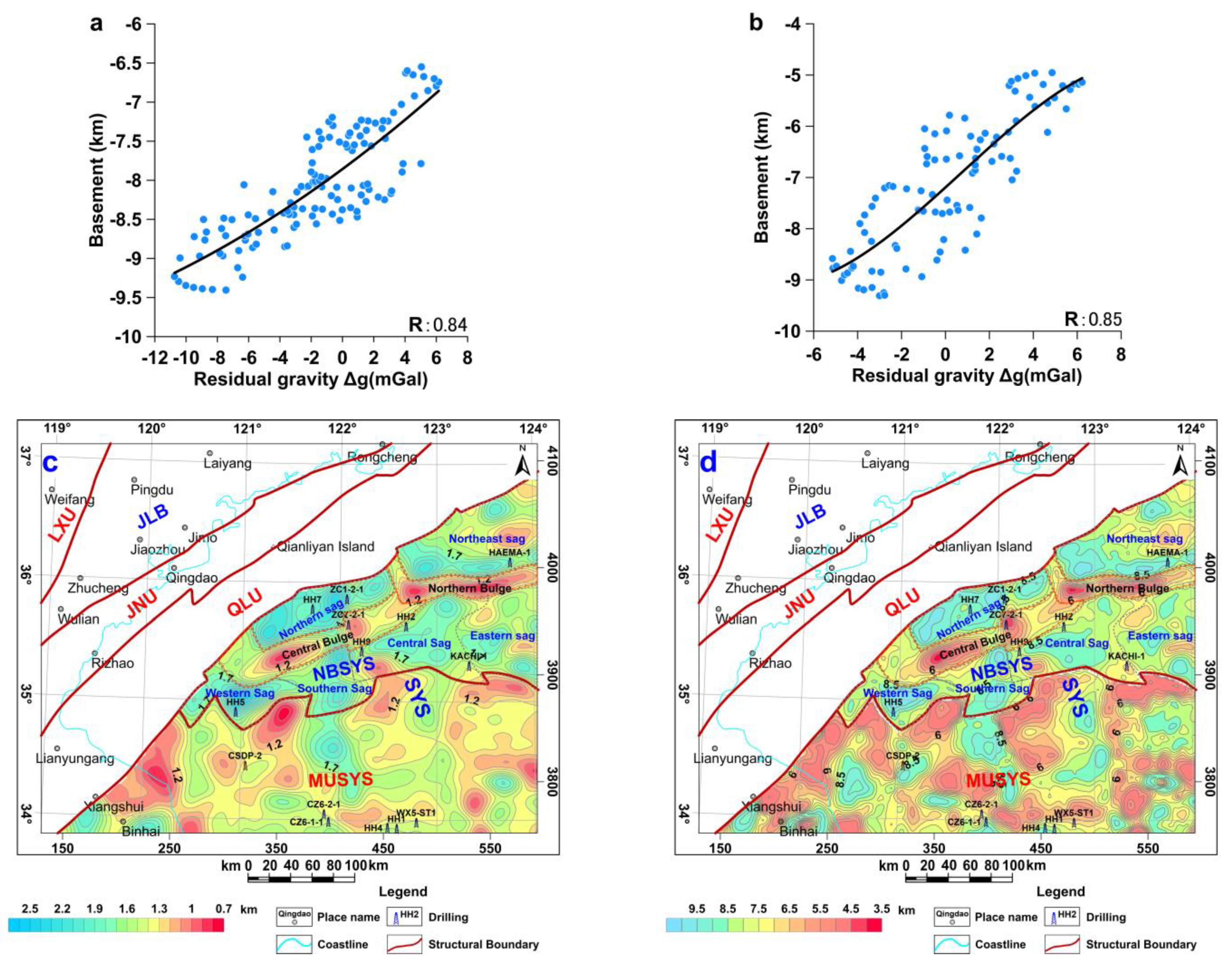

| Number | Basement Depth by Seismic Interpretation (m) | Basement Depth Calculated by the Regression Formula (m) | Difference (m) | Difference % |
|---|---|---|---|---|
| 1 | 7599.25 | 7564.64 | 34.61 | 0.46 |
| 2 | 7818.26 | 8468.2 | −649.94 | 7.68 |
| 3 | 7781.76 | 8515.16 | −733.4 | 8.61 |
| 4 | 6832.74 | 7538.48 | −705.74 | 9.36 |
| 5 | 7307.25 | 7441.83 | −134.58 | 1.81 |
| 6 | 7562.75 | 8093.74 | −530.99 | 6.56 |
| 7 | 6650.24 | 7549.32 | −899.08 | 11.81 |
| 8 | 6467.74 | 6664.87 | −197.13 | 2.96 |
| 9 | 8475.27 | 7889.26 | 586.01 | 7.42 |
| 10 | 8438.77 | 8773.33 | −334.56 | 3.81 |
| 11 | 9533.78 | 8841.07 | 692.71 | 7.84 |
| 12 | 8949.77 | 8781.61 | 168.16 | 1.91 |
| 13 | 8781.06 | 9376.66 | −595.6 | 6.35 |
| 14 | 7622.42 | 7460.35 | 162.07 | 2.17 |
| 15 | 6463.78 | 6502.93 | −39.15 | 0.60 |
| 16 | 7359.09 | 6506.29 | 852.8 | 13.11 |
| 17 | 8201.74 | 9091.95 | −890.21 | 9.79 |
| 18 | 7464.42 | 8252.78 | −788.36 | 9.55 |
| 19 | 9149.72 | 8941.66 | 208.06 | 2.33 |
Disclaimer/Publisher’s Note: The statements, opinions and data contained in all publications are solely those of the individual author(s) and contributor(s) and not of MDPI and/or the editor(s). MDPI and/or the editor(s) disclaim responsibility for any injury to people or property resulting from any ideas, methods, instructions or products referred to in the content. |
© 2023 by the authors. Licensee MDPI, Basel, Switzerland. This article is an open access article distributed under the terms and conditions of the Creative Commons Attribution (CC BY) license (https://creativecommons.org/licenses/by/4.0/).
Share and Cite
Xu, W.; Yao, C.; Yuan, B.; An, S.; Yin, X.; Yuan, X. Research on the Tectonic Characteristics and Hydrocarbon Prospects in the Northern Area of the South Yellow Sea Based on Gravity and Magnetic Data. Minerals 2023, 13, 893. https://doi.org/10.3390/min13070893
Xu W, Yao C, Yuan B, An S, Yin X, Yuan X. Research on the Tectonic Characteristics and Hydrocarbon Prospects in the Northern Area of the South Yellow Sea Based on Gravity and Magnetic Data. Minerals. 2023; 13(7):893. https://doi.org/10.3390/min13070893
Chicago/Turabian StyleXu, Wenqiang, Changli Yao, Bingqiang Yuan, Shaole An, Xianzhe Yin, and Xiaoyu Yuan. 2023. "Research on the Tectonic Characteristics and Hydrocarbon Prospects in the Northern Area of the South Yellow Sea Based on Gravity and Magnetic Data" Minerals 13, no. 7: 893. https://doi.org/10.3390/min13070893





